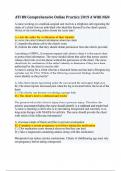Samenvatting
Summary Applied Methods and Statistics - Grade 9
This is a summary for the course Applied Methods and Statistics. It includes all the information given in the lectures (including examples and SPSS screenshots). I received a 9 for this course using this summary.
[Meer zien]













